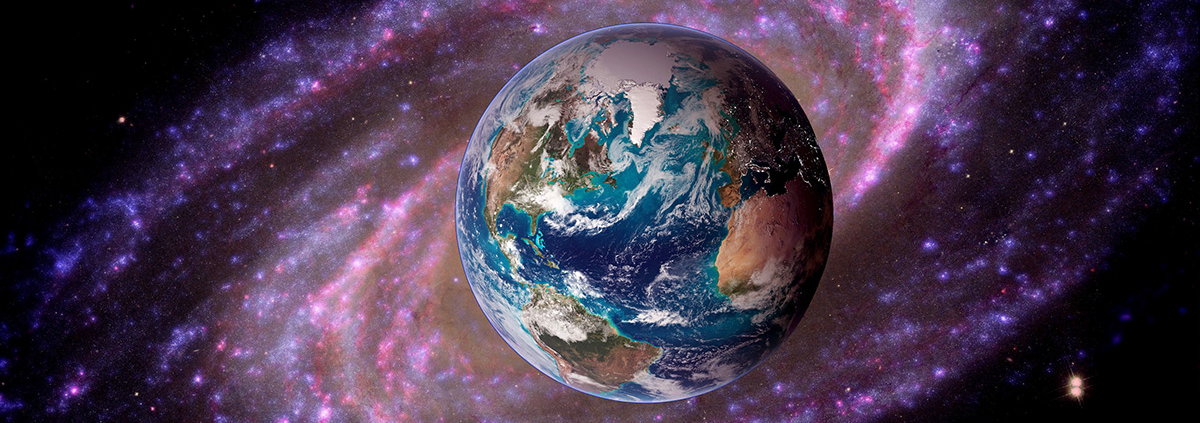#3 Privileged Planet Earth
The scientific evidence from the Big Bang model along with astronomical observation tell us that the universe was born 13.8 billion years ago and formed planet Earth 4.5 billion years ago. Also born in that first moment were the natural laws that govern the universe’s birth, death, and operation. Theists can’t imagine a universe born without a Creator, let alone imagine laws coming into existence without a Lawgiver. They can’t imagine atoms in motion without a Prime Mover. Reason alone tells us that whatever the cause of the universe and Earth (whether it’s God or something unknown), it must be transcendent, i.e., beyond nature, eternal, and unchanging. Something must be self-existent, eternal, and all-powerful or there would be nothing to discuss.
In this session, we take a look at how these fundamental laws and their parameters must be fixed ahead of time if planet Earth is to be formed out of the Big Bang. We will discover that these settings cannot be “blind” and must be predetermined. The settings are so elegantly fine-tuned that even a minuscule variation in any one of them (by just a hairbreadth) would negate the formation of our planet, or at least make it incapable of sustaining life. So remote is the probability of planet Earth being created by chance alone it would be comparable to tossing a bundle of 30 sharpened pencils into the air and having them all land on the table point down at one time!
There are four fundamental forces of nature — gravity, electromagnetism, and the strong and weak nuclear forces. They are so precisely fine-tuned with respect to one another that the universe runs like a perfect clock — every atom in the universe doing exactly what it is supposed to do. If these forces were just slightly “out of tune” no elements of matter would form. Biological life would be impossible. Scientists call this fine-tuning “the anthropic principle” because the settings are “just right” for life to exist on planet Earth. Let’s look at some of these settings:
Our “Just Right” Neighborhood
- Planet Earth is positioned “just right” within the Milky Way galaxy. Our sun and Earth are in the “just right” neighborhood. If they were any closer to the center of the Milky Way, we would be bombarded with deadly radiation.
- Our sun is a star that is not too big and not too small. It is not too hot and not too cool. It is not too young and not too old. It is “just right.” Our sun is in the “just right” neighborhood for carbon-based life to exist on Earth. Scientists say that we live in the “Goldilocks Zone.”
- The orbit of our planet around the Sun is “just right” — nearly circular instead of elliptical like many of the other planets. If otherwise, temperature variations would be too extreme.
- The axis of the Earth is tilted precisely right (23.5 degrees) for seasonal variation. Otherwise, the near perfect temperature range for life could not be maintained.
- The Earth’s rotational period is “just right” to allow sufficient warmth during the day and coolness at night so that plants and animals can flourish all over the earth.
- Our moon is totally unique compared to all the other moons in the solar system. Its size compared to Earth (a ratio some 50 times larger than any other moon-planet pair) and its closeness ensure the stability of the Earth’s axial tilt, and appropriately governs the Earth’s tidal action and nutrient recycling.
Our “Just Right” Construction Materials
- The Earth is a rocky planet with a crust, mantel, and a liquid iron core that produces the “just right” magnetic field surrounding the Earth to deflect harmful radiation from the Sun. At the same time, it allows the “just right” type of good radiation to reach the surface.
- Our atmosphere is nearly perfect in every way with its composition of nitrogen (78%), oxygen (21%), and carbon dioxide (0.04%). All the other planets (as well as the thousands of exo-planets — those outside our own solar system) have hostile atmospheres.
- The amount of oxygen is “just right.” A little more and one lightning strike could literally ignite the entire Earth instead of just starting a local forest fire. If the level of oxygen were a wee bit less, we would not be able to breathe and stay alive.
- Our atmosphere is perfectly fine-tuned to allow the “just right” amount of sunlight and the “just right” kind of sunlight (from the electromagnetic spectrum) to reach the surface of the Earth so that life can flourish.
The “Just Right” Molecules
One of these miracle molecules is water. Two gaseous atoms of hydrogen (H2) and one gaseous atom of oxygen (O) combine to form one liquid molecule of water (H2O). Its amazing qualities have no equal in all of science! That is why scientists attempt to discover liquid water first in their search for extra-terrestrial life. Look at these remarkable properties.
- Water’s “stickiness” (in freezing) helped form the solar system out of the cosmic dust cloud.
- Its surface tension and density make its solid state form (ice) float on top of our frozen lakes to allow fish below the surface to survive the winters.
- It facilitates the transport of water from a plant’s root system to the top of the plant so the plant won’t die.
- It has the perfect fitness to facilitate an incredible process called photosynthesis, which makes life on Earth possible. Animals breathe in oxygen and exhale carbon dioxide. Plants take in the carbon dioxide and give off oxygen for us to breathe. Water brings dissolved nutrients to the leaves. Sunlight supplies the energy for the chlorophyll in the leaves to split the water molecule into its component parts — hydrogen and oxygen. The oxygen is released into the air and the leaves then absorb the carbon dioxide. All this takes place in the precise right amounts and timing.
- Water plays a major role in erosion and tectonic activity (e.g., earthquakes) producing the soil necessary for vegetation. This action also recycles nutrients throughout the planet.
- Water makes up some 70% of our bodies, giving life to our cells that make up our organs — bones, lungs, kidneys (and our brain!), as well as our blood supply that delivers oxygen throughout our body.
- Through perspiration, water precisely regulates the extremely narrow range of mandatory temperature levels in which our body can function.
- Water’s hydrologic properties (evaporation and rainfall) allow planet Earth to miraculously teem with vegetation and animal life throughout.
- Water, with its minutely-tuned temperature range for remaining liquid (32 to 212 degrees Fahrenheit), fits with a “just right” atmospheric pressure on the planet (14.7 psi).
- And its beauty is unsurpassed whether it is in its ice, liquid, or vapor form!
The anthropic principle (all these “just right” conditions) demonstrates that the Earth was designed and is not the result of a series of astronomically improbable accidents. The theist sees God as the Grand Designer, whereas the naturalist must see accident upon accident to be the cause of all the “just right” conditions. At the same time the naturalist sees these incredible properties of nature as an “almost miracle” even though they cannot offer any realistic, scientific, natural pathway to account for such incredible fine-tuning. Sir Fred Hoyle, one of Great Britain’s most distinguished astronomers, and a self-avowed atheist/agnostic, said it well, “A common-sense interpretation of the facts suggests… that there are no blind forces worth speaking about in nature. The numbers one calculates from the facts seem to me so overwhelming as to put this conclusion almost beyond question.”
RECOMMENDED READING FOR FURTHER STUDY
The Anthropic Cosmological Principle, John D. Barrow and Frank J. Tippler, Oxford University Press, 1988
Improbable Planet: How Earth Became Humanity's Home, Hugh Ross, Baker Books, 2016
Privileged Planet: How Our Place in the Cosmos Is Designed for Discovery, Guillermo Gonzalez and Jay W. Richards, Regnery Publishing, 2004
Rare Earth: Why Complex Life is Uncommon in the Universe, Peter D. Ward, Donald Brownlee, Copernicus, 2003
The Wonder of Water: Water's Profound Fitness for Life on Earth and Mankind, Michael Denton, Discovery Institute Press, 2017
Four Views on Creation, Evolution, and Intelligent Design, Ken Ham, Hugh Ross, Deborah B. Haarsma, Stephen C. Meyer, James Stump, Stanley N. Gundry, Zondervan, 2017
Seven Days that Divide the World, The Beginning According to Genesis and Science, John C. Lennox, Zondervan, 2011



